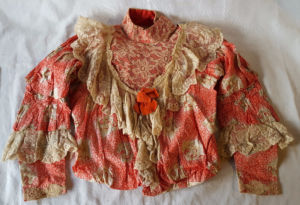
April 24, 2017
Our object of the week this week is a gorgeous bodice donated by Nancy Piazza. The bodice traveled from the donor’s great grandmother in Sicily to Piazza’s grandmother, who had settled in Minneapolis, MN. The Piazza family went on to establish the famous Café di Napoli in 1938, which ran for over 60 years before closing in 2005. Minnesota is well known as a state filled with German, Norwegian, Swedish, and Irish immigrants who came here in the 1800s and early 1900s. Yet there were also quite a few Italian families like the Piazzas, who established communities like the Beltrami neighborhood in Northeast Minneapolis, and whose stories are sometimes overlooked.
Italians came to Minnesota in the 1860s and settled in Saint Paul, while later waves began settling in Hennepin County and other parts of the state. A census from 1980 revealed that the number of Italians in Minnesota was the fourteenth highest ethnic group in the state, with the total heritage of Italians being 64,545. The vast majority of ethnic groups and immigrants in the earlier years of Minnesota came from more northern areas of Europe, and Italians who chose to settle in the Twin Cities were often faced with prejudice. “Other people in our new neighborhood [in Minneapolis] were alarmed at the idea that Italians were moving in, and they let my parents know,” wrote Linda Picone in the Star Tribune. Rose Totino, whose family opened one of the first pizzerias in Minneapolis and who later became the first female corporate vice president at Pillsbury and the third woman inducted into the Minnesota Inventors Hall of Fame, described her struggle to find pride in her Italian heritage growing up in a predominately Scandinavian city. Like Picone, she felt that her neighbors looked down on her and her family.
In response, Italians created a tightknit neighborhood in the Northeast Minneapolis neighborhood of Beltrami, named after Giacomo Beltrami, an Italian explorer who, with the help of Native Americans, searched for the headwaters of the Mississippi River in what would later become Minnesota. The area was home to Delmonico’s, a beloved Italian grocery store that sold wholesale to the Café Di Napoli. The nickname of the neighborhood, “Dogtown” betrays the prejudice against Italians. Some suggest that the name Dogtown was derived from the term “dago,” a derogatory work meaning an Italian that also gave name to the sandwich, the “Hot Dago.” In both 1991 and 2007, people attempted to have the name of the sandwich banned, but were ultimately unsuccessful. One possible reason for this was that some Italian restaurants had adopted the term for the sandwich themselves, though it was often called the “Italiano” as well. Another possibility is that with the smaller percentage of Italians in the cities, the Scandinavian majority didn’t find the term offensive. Today the term is still in use in Northeast, west of Beltrami, at Dusty’s Bar and Dagos. They advertise their “Homemade Dagos” on a large sign on the side of the building and serve the sandwich as their specialty.
In 2010, Joseph Piazza passed away at his daughter Nancy Piazza’s home at the age of 92. The Café Di Napoli had been a destination point for celebrities, and one of many successful Italian businesses in the Twin Cities. Italians, like many immigrants across the United States throughout its history and still today, were faced with the ongoing and unfortunate cycle of discrimination and xenophobia. Italians preserved their culture in part through their restaurants and saving objects like the Piazza family bodice, just as museums like the Somali Museum of Minnesota hope to help preserve the culture of immigrants in Minnesota and feel pride in their heritage, and museums like the Swedish Institute have done for many years. Hennepin History Museum highlights the Piazza family bodice to help Minnesotans learn more about another piece in the mosaic of cultures in our state.
Written by HHM intern Caitlin Crowley. Caitlin is a current Augsburg student where she is majoring in history with a Medieval History minor. She comes to HHM through the Minnesota Historical Society’s ACTC extern program.
Sources
Esther Jerabek, “Minnesota: Melting Pot of Many Peoples,” Gopher Historian, Spring 1967.
“Italian-Americans take pride in their culture: Newspaper staff members reflect on meaning of Italian heritage,” Minneapolis Star and Tribune, October 8, 1984.
“Life in Minnesota sometimes leaves a little room for being Italian,” Star and Tribune, October 8, 1984.
Paul Klauda, “Melting pot at work in Minnesota, but ethnic differences add spice,” Minneapolis Star and Tribune, July 2, 1986.
Peg Meier, “Minnesotans’ experiences show immigrants can’t be stereotyped,” Star Tribune, July 2, 1986.
“ROSE TOTINO – 2008 INDUCTEE,” Minnesota Inventors Hall of Fame, http://www.minnesotainventors.org/inductees/rose-totino.html.
Tim Harlow, “Joseph Piazza ran Cafe di Napoli for decades,” Star Tribune, March 16, 2010, http://www.startribune.com/joseph-piazza-ran-cafe-di-napoli-for-decades/87975592/. Ware Carlton-Ford, “A Timeline of Italian Food in Minnesota,” http://heavytable.com/timeline-italian-food-minnesota/.
